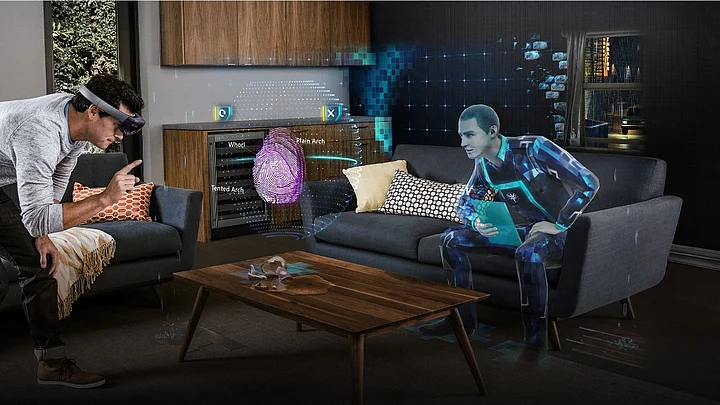We live in strange times. Tech giants around the globe are working overtime to bring about the next big revolution – Virtual Reality (VR). Consumers are being egged on to spend insane amounts of money to put on huge plastic visors such as the Oculus Rift and Samsung Gear VR, so they can escape into a CGI-created virtual world.
For the past couple of years, Facebook’s Oculus has been at the forefront of this revolution. However, on the first day of its annual F8 developer conference, the tech firm’s CEO Mark Zuckerberg changed the script and made a renewed push for the Augmented Reality (AR) market, which, according to estimates, is expected to swell up to $117 billion by 2022.
But what is AR, and how does it differ from its more fancy sibling, Virtual Reality? The Quint explains.
Augmented Reality (AR)
Augmented Reality (AR), a term that was coined in 1992 by researcher Tom Caudell, is a technology that enables the real-world experience to be supplemented by a virtual layer of data, which when executed correctly, creates content that blends in with the real world.
Too complicated, right? Here’s a simpler definition:
Augmented Reality enables users to interact with virtual content in the real world, while being able to distinguish between the two at all times. Remember Pokemon GO? That’s Augmented Reality.
Through a smartphone’s camera it simply augments our surroundings. That is what is being implemented in Pokemon GO, and Facebook’s recently announced Camera Effects Platform for developers.
Virtual Reality (VR)
Virtual reality (VR) is an artificial recreation of the real world that immerses the user in a computer-generated simulated reality. The technology requires expensive enablers such as headsets, which completely block out the users’ surroundings. However, because of the nature of the technology, the user is left blind to the outside world, leaving the technology at a disadvantage when it comes to everyday use.
There are multiple possibilities for implementation of VR, but because it involves completely replacing the surroundings around the user with an artificial layer, the future of VR is seen to be in creating immersive games.
Zuckerberg’s Push for AR
The technology has been around for some time now and because of its nature of enabling users to interact with virtual content in the real world, AR has found a wider spectrum of applications. From real-world applications in games to defence, healthcare, and education, AR has found itself proving useful for a greater audience.
However, as Mark Zuckerberg explained at the F8 developers’ conference, this is just the tip of the iceberg. The real use of AR can be mind-boggling as it holds the potential to completely change the way we interact with technology.
Think about how many of the things you use that don’t actually need to be physical. You want to play a board game? You snap your fingers, and here’s the board game. You want to watch TV? Here it is... You don’t need physical hardware TV, you buy a one-dollar app ‘TV’ and put it on the wall.
Zuckerberg at the F8 conference also spoke about how he sees AR taking centrestage in the future. He said, “We can’t build the AR product that we want today, so building VR is the path to getting to those AR glasses... I would bet the AR one will be bigger if it can get developed in a good way.”
Where Does India Stand in the Race for Mastery of AR?
India has been slow to wake up to its potential, with most Indian startups in the field still focused on making a mark in the VR segment of the market. However, there are a few that have woken up to the immense possibilities that AR holds.
Though we are still far from rivalling the work of Microsoft and its hologram-themed augmented reality glass or Google’s Tango project, there are some Indian firms making a meaningful contribution in the evolution of AR tech.
FlippAR is one such interesting Indian take on the technology. A startup based out of Bengaluru, the platform uses your phone’s GPS and camera to display additional information, such as reviews and promotions about a restaurant that the user is near. It can also help users by supplementing them with information about known landmarks. All it takes is a simple scan using the mobile phone camera.
Gamooz is another interesting implementation of AR tech by an Indian company. Brainchild of a Gurgaon based startup, Gamooz uses AR to create interactive textbooks. The app takes advantage of the users phone to bring to life simple textbooks by adding a ton of extra multimedia content to it.
With a simple scan, users can unlock related information in form of videos and images about the topic they are researching on. However, the app is in a nascent stage and as such is bottle-necked by its limited number of partners.
Imaginate is another company that is fast making a name for itself in the AR/VR space. Imaginate has a number of AR/VR based apps to its credit, with most of its products aimed for specific clients.
From ShootAR – an Augmented Reality simulator developed for the Indian Army – to LiveVR that helps doctors navigate complicated open liver surgeries, the company has been making serious strides in the Augmented Reality space.
